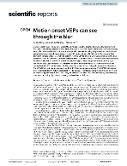Motion onset VEPs can see through the blur

Publication date
2024Published in
Scientific ReportsVolume / Issue
14 (1)ISBN / ISSN
ISSN: 2045-2322ISBN / ISSN
eISSN: 2045-2322Metadata
Show full item recordCollections
This publication has a published version with DOI 10.1038/s41598-024-72483-z
Abstract
MMotion-onset visual evoked potentials (MO VEPs) are robust to dioptric blur when low contrast and low spatial frequency patterns are used for stimulation. To reveal mechanisms of MO VEPs robustness, we studied whether the resistance to defocus persists even when using a high-contrast checkerboard using digital defocus in the emmetropic eyes of 13 subjects (males 20-60 years). We compared the dominant components of MO VEPs to pattern-reversal VEPs (PR VEP), which are sensitive to the blur. For stimulation, we used checkerboard patterns with 15' and 60' checks. To defocus the checkerboard, we rendered it with a second-order Zernike polynomial ( Z02 ) with an equivalent defocus of 0, 2, or 4 D. For PR VEP, the checkerboards were reversed in terms of their contrast. To evoke MO VEP, the checkerboard of 60' checks moved for 200 ms with a speed of 5 or 10 deg/s in the cardinal directions. The MO VEP did not change in peak time (P >= 0.0747) or interpeak amplitude (P > 0.0772) with digital blur. In contrast, for PR VEP, the results showed a decrease in interpeak amplitude (P <= 6.65ˑ10-4) and an increase in peak time (P <= 0.0385). Thus, we demonstrated that MO VEPs evoked by checkerboard, structure containing high spatial content, can be robust to defocus.
Keywords
Digital blur, Motion-onset, Pattern-reversal, Visual evoked potential
Permanent link
https://hdl.handle.net/20.500.14178/2617License
Full text of this result is licensed under: Creative Commons Uveďte původ 4.0 International







